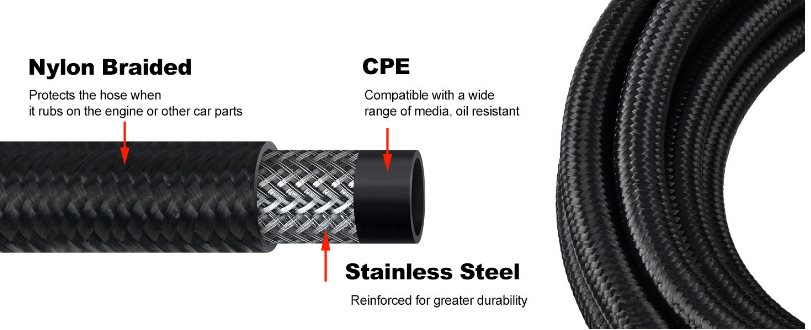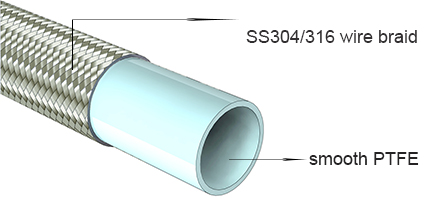Selecting the proper hose optimizes the performance and durability of any given application. Even though significant usage of both CPE and PTFE hoses is in the industrial and automotive departments, they differ in the range of temperatures and the type of chemicals they can handle.
We have compared multiple features of both, and the comparison also leads to a recommendation. However, this recommendation may vary from case to case as every application scenario differs, and decisions should be made accordingly.
CPE hose: (All You Need to Know)
A Chlorinated Polyethylene (CPE) hose is a double-braided stainless hose made of high-quality stainless steel. The chlorinated polyethylene inner tube provides borax race fluid compatibility.
CPE hose is generally used due to its ability to handle a wide range of temperatures and its flexibility and durability, which comes in handy in automotive and industrial applications.
Material and Structure:
The hose is constructed with a stainless-steel outer braid to resist abrasion and corrosion; it is combined with a chlorinated polyethylene inner rubber tube lined with a nylon inner braid, making it even more resistant to some chemicals.
These layers of CPE make it resistant, but when it comes to handling high-intensity chemicals – CPE is not widely trusted as it is not entirely resistant to those.

PTFE Hose:
PTFE is a more versatile and durable alternative to rubber hoses and shares some standard features with CPE hoses. PTFE – polytetrafluoroethylene is used as a liner for stainless steel braided hoses or rubber hoses to make them more resistant to temperature changes and chemicals, making them more durable and shock resistant.
Material and Structure:
PTFE hoses have a PTFE lining that is mainly used in cookware for coating purposes. For context, PTFE is also used in medical devices and the manufacturing of semiconductors. Various products like shaving blades, containers of chemicals, and even eyeglasses require polytetrafluoroethylene coating.
PTFE is neither metal nor rubber, but it is a thermoplastic polymer with a slippery characteristic.
The melting point of this material is very high and is almost resistant to all chemicals, including some mighty ones.

Which Is Better and Why:
· Choosing CPE over PTFE:
CPE hose is suitable for moderate temperatures and provides good resistance to synthetic fluids, like coolants, lubricants, and oils. It can also withstand moderate temperatures up to 150°C, which works well for many automotive and industrial applications.
CPE hose offers more flexibility than PTFE hose, so that it can be easily used in tight spaces. Also, the price point of CPE hose is lower than that of PTFE, which gives the added benefit of cost-effectiveness with adequate temperature and chemical resistance.
· Choosing PTFE over CPE:
PTFE hose is a more extreme and resistant version of CPE hose, so it is more durable in industries that require temperature control and chemical inertness.
PTFE hose can withstand temperatures from -65°C to 260°C and up to 5500 psi pressure. Regarding chemicals, PTFE takes the lead as it has a special coating that makes it nonreactive to almost all substances.
High chemical and temperature resistance means that PTFE hoses will wear down way more slowly than CPE.
If you need hoses for transferring powerful chemicals, like solvents in the petroleum sector, for pesticide spray, pharmaceuticals, and aerospace applications, PTFE is better than CPE hoses.
How to Select the Right Hose for You?
Selecting the proper hose for you involves an analysis of your specific requirements and application scenarios. Three main factors will influence your decision:
1. Chemical Exposure
2. Temperature Extremes
3. Cost vs. Performance
If you need hoses for harsh and potent chemicals, the right choice for you will be the PTFE hose that PTFE hose manufacturers like Passion Hose recommend.
Additionally, the fluid temperature will determine the most suitable hose material. If it is less than 150 °C, the CPE hose will be better than the PTFE hose.
In the end, you must choose between cost and performance. Even though the CPE hose provides cost-effectiveness upfront, you may prefer the long-term performance and durability offered by the PTFE hose.
Conclusion
If we talk about the better option, then it is true that there is never a choice with all the pros and cons. Every option is a combination of both. Similarly, choosing between CPE and PTFE hose balances chemical exposure, temperature extremes, and cost vs. performance analysis. Considering these factors will give you the material that meets your needs and provides durability in the long run.
Considering Hose for Your Specific Needs?
If you are interested in acquiring high-quality PTFE or CPE hoses, Passion Hose is a trusted name in the market that stands out as one of the most trusted and reliable manufacturers of PTFE, having a legacy of serving our customers for more than 15 years.